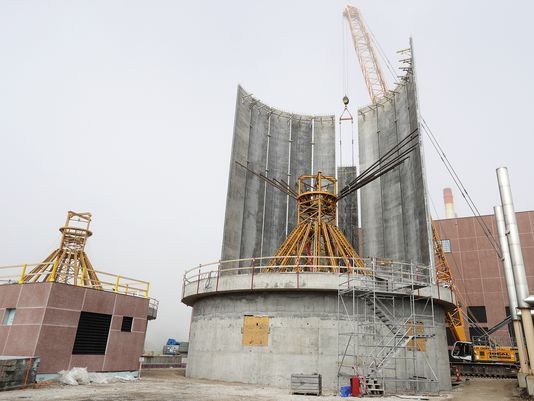Massive Biodigesters Produce Energy to Run the Sewer Plant
Published on by Water Network Research, Official research team of The Water Network in Technology
NEW Water’s massive, $169 million construction project will ensure almost nothing it treats goes to waste.

A crane hoists an outside panel of one of tow anaerobic biodigesters being built at the NEW Water wastewater treatment plant in Green Bay. The biodigester will convert organic material at the plant into methane gas, which will be burned to generate roughly 50-percent of the plant's energy needs.(Photo: Adam Wesley/USA TODAY NETWORK-Wi)
For the past week, C.D. Smith Construction has been raising the walls on two, 65-foot wide, 120-foot tall anaerobic biodigesters that will produce energy to run the sewer plant and a revenue-generating byproduct. Once completed, the biodigesters will each hold 2.25 million gallons of solid waste, NEW Water Executive Director Tom Sigmund said. Solid waste is poop, paper and industrial organic waste.
The biodigesters mix microbes with the solid waste to produce methane, which can be burned to produce electricity to power the wastewater treatment plant, and fertilizer.
“This project is the single largest expenditure in our 86-year history,” Sigmund said. “This is material we get coming in that others consider to be a waste. But there’s still an awful lot of value in that material.”
The electricity produced by the project is expected to cut the plant’s energy bill in half. A company has agreed to buy the leftover waste for a projected $400,000 each year and convert it into a fertilizer called struvite.
“This is a different mindset for our business, trying to extract value from what our customers give us,” Sigmund said. “We’re seeing it’s not just a material to dispose of. There’s an opportunity to do more with it and that’s where we’re at.”
The project was selected from 16 options considered by the regional sewer district, which serves 18 communities. Planning started in 2008 when it became clear the Quincy Street sewage treatment plant’s infrastructure was wearing out after 40 years of use. Presently, NEW Water incinerates the solid waste on site and hauls the leftover ash to a landfill.
Sigmund said NEW Water went out to communities, businesses and customers to get input on how best to upgrade and expand the plant, while ensuring the utility would continue to comply with Environmental Protection Agency regulations.
The result was the $169 million package of improvements and new construction that includes a new solids building, the biodigester silos, new power-generating equipment and other improvements.
Read more: Green Bay Press Gazette
Media
Taxonomy
- Solid Waste Management
- Sewage Treatment
- Raw Sewage Recycling
- Technology
- Solid Wastes & Wastewater Recycling
- Sewage
- Energy Efficiency
- Infrastructure
- Waste Management
1 Comment
-
Not bad, but I can show them how to reduce their aeration operating costs by an additional 60% and eliminate the Atmospheric CO2 and dramatically reclaim nutrients to make their facility a zero waste net positive cash flow scenario. Visit www.aquagen-isi.com to see how we do it. Our system is more organically based vs the mechanical focus of most contemporary systems. - BBS